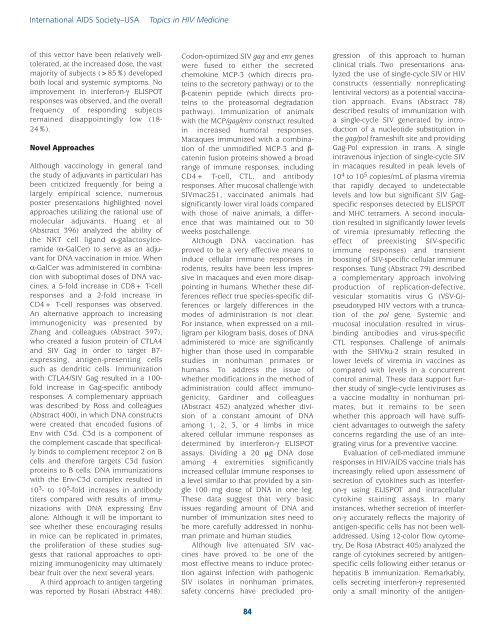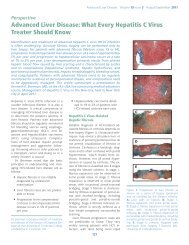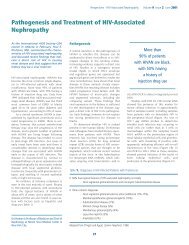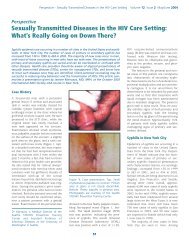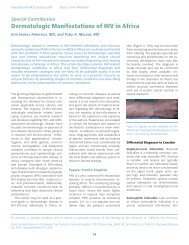Topics in HIV Medicine® - International AIDS Society-USA
Topics in HIV Medicine® - International AIDS Society-USA
Topics in HIV Medicine® - International AIDS Society-USA
Create successful ePaper yourself
Turn your PDF publications into a flip-book with our unique Google optimized e-Paper software.
<strong>International</strong> <strong>AIDS</strong> <strong>Society</strong>–<strong>USA</strong><br />
<strong>Topics</strong> <strong>in</strong> <strong>HIV</strong> Medic<strong>in</strong>e<br />
of this vector have been relatively welltolerated,<br />
at the <strong>in</strong>creased dose, the vast<br />
majority of subjects (>85%) developed<br />
both local and systemic symptoms. No<br />
improvement <strong>in</strong> <strong>in</strong>terferon-γ ELISPOT<br />
responses was observed, and the overall<br />
frequency of respond<strong>in</strong>g subjects<br />
rema<strong>in</strong>ed disappo<strong>in</strong>t<strong>in</strong>gly low (18-<br />
24%).<br />
Novel Approaches<br />
Although vacc<strong>in</strong>ology <strong>in</strong> general (and<br />
the study of adjuvants <strong>in</strong> particular) has<br />
been criticized frequently for be<strong>in</strong>g a<br />
largely empirical science, numerous<br />
poster presentations highlighted novel<br />
approaches utiliz<strong>in</strong>g the rational use of<br />
molecular adjuvants. Huang et al<br />
(Abstract 396) analyzed the ability of<br />
the NKT cell ligand α-galactosylceramide<br />
(α-GalCer) to serve as an adjuvant<br />
for DNA vacc<strong>in</strong>ation <strong>in</strong> mice. When<br />
α-GalCer was adm<strong>in</strong>istered <strong>in</strong> comb<strong>in</strong>ation<br />
with suboptimal doses of DNA vacc<strong>in</strong>es,<br />
a 5-fold <strong>in</strong>crease <strong>in</strong> CD8+ T-cell<br />
responses and a 2-fold <strong>in</strong>crease <strong>in</strong><br />
CD4+ T-cell responses was observed.<br />
An alternative approach to <strong>in</strong>creas<strong>in</strong>g<br />
immunogenicity was presented by<br />
Zhang and colleagues (Abstract 397),<br />
who created a fusion prote<strong>in</strong> of CTLA4<br />
and SIV Gag <strong>in</strong> order to target B7-<br />
express<strong>in</strong>g, antigen-present<strong>in</strong>g cells<br />
such as dendritic cells. Immunization<br />
with CTLA4/SIV Gag resulted <strong>in</strong> a 100-<br />
fold <strong>in</strong>crease <strong>in</strong> Gag-specific antibody<br />
responses. A complementary approach<br />
was described by Ross and colleagues<br />
(Abstract 400), <strong>in</strong> which DNA constructs<br />
were created that encoded fusions of<br />
Env with C3d. C3d is a component of<br />
the complement cascade that specifically<br />
b<strong>in</strong>ds to complement receptor 2 on B<br />
cells and therefore targets C3d fusion<br />
prote<strong>in</strong>s to B cells. DNA immunizations<br />
with the Env-C3d complex resulted <strong>in</strong><br />
10 3 - to 10 5 -fold <strong>in</strong>creases <strong>in</strong> antibody<br />
titers compared with results of immunizations<br />
with DNA express<strong>in</strong>g Env<br />
alone. Although it will be important to<br />
see whether these encourag<strong>in</strong>g results<br />
<strong>in</strong> mice can be replicated <strong>in</strong> primates,<br />
the proliferation of these studies suggests<br />
that rational approaches to optimiz<strong>in</strong>g<br />
immunogenicity may ultimately<br />
bear fruit over the next several years.<br />
A third approach to antigen target<strong>in</strong>g<br />
was reported by Rosati (Abstract 448).<br />
84<br />
Codon-optimized SIV gag and env genes<br />
were fused to either the secreted<br />
chemok<strong>in</strong>e MCP-3 (which directs prote<strong>in</strong>s<br />
to the secretory pathway) or to the<br />
β-caten<strong>in</strong> peptide (which directs prote<strong>in</strong>s<br />
to the proteasomal degradation<br />
pathway). Immunization of animals<br />
with the MCP/gag/env construct resulted<br />
<strong>in</strong> <strong>in</strong>creased humoral responses.<br />
Macaques immunized with a comb<strong>in</strong>ation<br />
of the unmodified MCP-3 and β-<br />
caten<strong>in</strong> fusion prote<strong>in</strong>s showed a broad<br />
range of immune responses, <strong>in</strong>clud<strong>in</strong>g<br />
CD4+ T-cell, CTL, and antibody<br />
responses. After mucosal challenge with<br />
SIVmac251, vacc<strong>in</strong>ated animals had<br />
significantly lower viral loads compared<br />
with those of naive animals, a difference<br />
that was ma<strong>in</strong>ta<strong>in</strong>ed out to 30<br />
weeks postchallenge.<br />
Although DNA vacc<strong>in</strong>ation has<br />
proved to be a very effective means to<br />
<strong>in</strong>duce cellular immune responses <strong>in</strong><br />
rodents, results have been less impressive<br />
<strong>in</strong> macaques and even more disappo<strong>in</strong>t<strong>in</strong>g<br />
<strong>in</strong> humans. Whether these differences<br />
reflect true species-specific differences<br />
or largely differences <strong>in</strong> the<br />
modes of adm<strong>in</strong>istration is not clear.<br />
For <strong>in</strong>stance, when expressed on a milligram<br />
per kilogram basis, doses of DNA<br />
adm<strong>in</strong>istered to mice are significantly<br />
higher than those used <strong>in</strong> comparable<br />
studies <strong>in</strong> nonhuman primates or<br />
humans. To address the issue of<br />
whether modifications <strong>in</strong> the method of<br />
adm<strong>in</strong>istration could affect immunogenicity,<br />
Gard<strong>in</strong>er and colleagues<br />
(Abstract 452) analyzed whether division<br />
of a constant amount of DNA<br />
among 1, 2, 3, or 4 limbs <strong>in</strong> mice<br />
altered cellular immune responses as<br />
determ<strong>in</strong>ed by <strong>in</strong>terferon-γ ELISPOT<br />
assays. Divid<strong>in</strong>g a 20 µg DNA dose<br />
among 4 extremities significantly<br />
<strong>in</strong>creased cellular immune responses to<br />
a level similar to that provided by a s<strong>in</strong>gle<br />
100 mg dose of DNA <strong>in</strong> one leg.<br />
These data suggest that very basic<br />
issues regard<strong>in</strong>g amount of DNA and<br />
number of immunization sites need to<br />
be more carefully addressed <strong>in</strong> nonhuman<br />
primate and human studies.<br />
Although live attenuated SIV vacc<strong>in</strong>es<br />
have proved to be one of the<br />
most effective means to <strong>in</strong>duce protection<br />
aga<strong>in</strong>st <strong>in</strong>fection with pathogenic<br />
SIV isolates <strong>in</strong> nonhuman primates,<br />
safety concerns have precluded progression<br />
of this approach to human<br />
cl<strong>in</strong>ical trials. Two presentations analyzed<br />
the use of s<strong>in</strong>gle-cycle SIV or <strong>HIV</strong><br />
constructs (essentially nonreplicat<strong>in</strong>g<br />
lentiviral vectors) as a potential vacc<strong>in</strong>ation<br />
approach. Evans (Abstract 78)<br />
described results of immunization with<br />
a s<strong>in</strong>gle-cycle SIV generated by <strong>in</strong>troduction<br />
of a nucleotide substitution <strong>in</strong><br />
the gag/pol frameshift site and provid<strong>in</strong>g<br />
Gag-Pol expression <strong>in</strong> trans. A s<strong>in</strong>gle<br />
<strong>in</strong>travenous <strong>in</strong>jection of s<strong>in</strong>gle-cycle SIV<br />
<strong>in</strong> macaques resulted <strong>in</strong> peak levels of<br />
10 4 to 10 5 copies/mL of plasma viremia<br />
that rapidly decayed to undetectable<br />
levels and low but significant SIV Gagspecific<br />
responses detected by ELISPOT<br />
and MHC tetramers. A second <strong>in</strong>oculation<br />
resulted <strong>in</strong> significantly lower levels<br />
of viremia (presumably reflect<strong>in</strong>g the<br />
effect of preexist<strong>in</strong>g SIV-specific<br />
immune responses) and transient<br />
boost<strong>in</strong>g of SIV-specific cellular immune<br />
responses. Tung (Abstract 79) described<br />
a complementary approach <strong>in</strong>volv<strong>in</strong>g<br />
production of replication-defective,<br />
vesicular stomatitis virus G (VSV-G)-<br />
pseudotyped <strong>HIV</strong> vectors with a truncation<br />
of the pol gene. Systemic and<br />
mucosal <strong>in</strong>oculation resulted <strong>in</strong> virusb<strong>in</strong>d<strong>in</strong>g<br />
antibodies and virus-specific<br />
CTL responses. Challenge of animals<br />
with the S<strong>HIV</strong>ku-2 stra<strong>in</strong> resulted <strong>in</strong><br />
lower levels of viremia <strong>in</strong> vacc<strong>in</strong>es as<br />
compared with levels <strong>in</strong> a concurrent<br />
control animal. These data support further<br />
study of s<strong>in</strong>gle-cycle lentiviruses as<br />
a vacc<strong>in</strong>e modality <strong>in</strong> nonhuman primates,<br />
but it rema<strong>in</strong>s to be seen<br />
whether this approach will have sufficient<br />
advantages to outweigh the safety<br />
concerns regard<strong>in</strong>g the use of an <strong>in</strong>tegrat<strong>in</strong>g<br />
virus for a preventive vacc<strong>in</strong>e.<br />
Evaluation of cell-mediated immune<br />
responses <strong>in</strong> <strong>HIV</strong>/<strong>AIDS</strong> vacc<strong>in</strong>e trials has<br />
<strong>in</strong>creas<strong>in</strong>gly relied upon assessment of<br />
secretion of cytok<strong>in</strong>es such as <strong>in</strong>terferon-γ<br />
us<strong>in</strong>g ELISPOT and <strong>in</strong>tracellular<br />
cytok<strong>in</strong>e sta<strong>in</strong><strong>in</strong>g assays. In many<br />
<strong>in</strong>stances, whether secretion of <strong>in</strong>terferon-γ<br />
accurately reflects the majority of<br />
antigen-specific cells has not been welladdressed.<br />
Us<strong>in</strong>g 12-color flow cytometry,<br />
De Rosa (Abstract 405) analyzed the<br />
range of cytok<strong>in</strong>es secreted by antigenspecific<br />
cells follow<strong>in</strong>g either tetanus or<br />
hepatitis B immunization. Remarkably,<br />
cells secret<strong>in</strong>g <strong>in</strong>terferon-γ represented<br />
only a small m<strong>in</strong>ority of the antigen-


